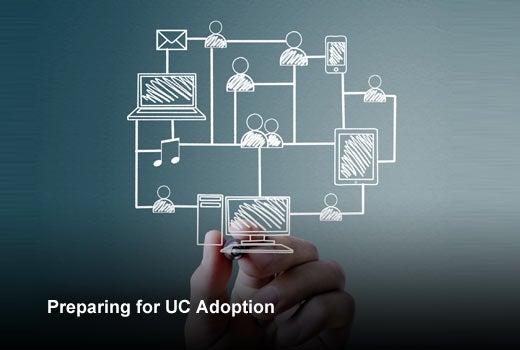Unified communications (UC) services pull together a variety of communication platforms that can help organizations become more productive by offering frictionless access to the right information, in the right context, and at the right time. Enterprises are utilizing these platforms more than ever. In fact, according to a report by Osterman Research, UC adoption will continue to rise over the next couple of years. Today, 45 percent of users touch a UC system, whereas Osterman expects that number to rise to 68 percent in 2017.
With this growth, there is an essential need to develop and maintain viable solutions for the industry. Before success with a unified communication platform, companies must know what platform is best and best practices to enforce these systems into the culture of their company. To help with this issue, Tata Communications shares four things every company should think about before and while installing a unified communications system.
Preparing for UC Adoption
Click through for four things every company should think about before and while installing a unified communications system, as identified by Tata Communications.
All-in-One Systems
According to a report commissioned by Sonus, 72 percent of respondents had either partially or fully deployed UC solutions within enterprise environments. The finding confirms that companies are using different platforms for voice, video, conferencing and messaging, and it is frequently that complexity that can slow them from moving from “partially deployed” to more fully deployed.
When either users or administrators have to deal with multiple vendors, hardware infrastructures, software systems, hosting providers and support services, the full functionality and productivity gains of UC aren’t achieved. This means when an issue occurs with one part of your UC platform, the whole system suffers and it takes longer and requires more time and resources to manage.
All-in-One Systems
One way to control the complexity is by utilizing an all-in-one system. An all-in-one system can be used on its own to support voice communications, conferencing, file sharing and other UC solutions you already utilize. Additionally, these systems can also be used as a private branch exchange (PBX) replacement. With some additional equipment and system configuration, full PBX functionality, including connection to the outside telephone network, is possible. This would add to the other numerous UC solutions these platforms guarantee. By utilizing this kind of platform, not only will your company save costs and streamline support, but it should also help reduce complexity and increase employee productivity.
Security Concerns
Unified communications presents unique security challenges because it brings together disparate technologies. A unified communications system can include voice calls, online messaging, video, screen sharing and more. Each of those capabilities has a different security concern, and with the Internet being easier than ever to attack, companies must pay close attention to security and perform regular checks for risk and vulnerability. According to InformationWeek’s 2014 State of Unified Communications, 65 percent of respondents deploying or planning to deploy unified communications say security or compliance worries have had no effect on their strategy.
It is critical for enterprises to be aware of all possible security risks, including DDoS attacks, and have security top of mind before employing these platforms. One solution for this is to partner with a network company with experience providing secure connections across multiple vendors’ equipment and a wide range of deployment scenarios. For example, even if the hardware or systems that are used are capable of encryption, the underlying service provider networks should be certified to support the appropriate interconnections to ensure full compliance.
Customer and Employee Training
Once an enterprise has its UC platform set up, it’s important to train customers and employees on the systems accordingly. A new report from XO Communications and IDG found that while respondents were clear about the benefits of adopting UC into daily work, 24 percent indicated they had not received sufficient training so they could maximize the value of the UC tools available to them.
Companies that hold training sessions and classes are most likely to see end users leveraging their features to the highest capability. When changing UC systems, the technology changes can be difficult enough. As such, “training” can’t be only a one-time approach or just sending out a new manual. Users may also have to deal with systems that provide functions in a new or different way. This is ultimately what also contributes to productivity. With proper training, users are able to capitalize on the myriad of features and increase productivity. With proper training, early detractors can sometimes turn into the best internal evangelists.
Legal
Customers across a number of organizations depend on contracts and licensing to move forward with their systems. This allows those organizations to access a wide range of applications and services in a cost-effective, simple package. If a company does not pay attention to its license requirements, it could be losing out on critical applications that it is not aware of. Many organizations already have unused licenses as part of previous deployments or packaged systems, either in terms of the number of users or in terms of the included functionality that wasn’t initially deployed. That is especially true for partial UC deployments. Those unused licensees could be leveraged to lower recurring and deployments costs. A survey conducted by IntelliCom Analytics looked at whether respondents would be receptive to purchasing UC licenses using a bundled approach rather than a single feature. Interestingly, the survey found that 34 percent of respondents were open to the bundling approach. As providers begin to package UC application licenses into a bundle, customers may be getting duplicate licenses and paying for both. It is important to understand which license you have and combine them all together to ensure you are only paying for what you need.








